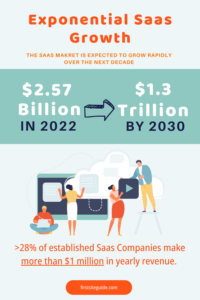What Are SaaS Products?
Everything You Need to Know About Most Popular SaaS Business Models and Products

According to the latest SaaS industry statistics, about 30,000 SaaS companies operate worldwide, with +8,550 generating over $1 million in revenue. Experts estimate the market will grow dramatically, reaching nearly $1.3 trillion by 2030.
Now is the time to start a SaaS company and get your piece of the financial pie. The question is, what SaaS product should you offer? What business model should you choose?
Find a suitable pick below and discover the essential elements of SaaS products.
What are SaaS products?
SaaS (Software as a Service) products are cloud-based solutions that don’t require downloading and installing software. They’re available online for a monthly or annual fee, running on SaaS providers’ servers and enabling users to access the features via web browsers and use them on the go. SaaS vendors handle the maintenance, security, and updates, taking a load off their clients’ IT staff.
However, you don’t have to build a SaaS product from scratch. You can get a white-label SaaS to rebrand and market as your own. Think of it as leasing the software and selling it under your brand.

Crucial elements of SaaS products
All SaaS products have the following essential elements:
- Accessibility – Being cloud-based solutions, SaaS products give users on-demand access, eliminating the need for downloads and installations. That means no setup and maintenance costs on the user’s end, making SaaS solutions attractive to consumers.
- Scalability – Customers can scale SaaS products to accommodate their changing needs. They can expand the capacity as their businesses grow or reduce it during low demand to avoid wasting resources.
- Integration – SaaS products integrate with multiple third-party apps to help users work seamlessly with their favorite cloud tools or on-premise systems.
- Automatic updates – SaaS providers regularly update their products, ensuring they remain accessible, functional, and secure. Users don’t need to worry about maintaining the infrastructure or implementing the latest security measures.
These benefits make SaaS products fantastic for consumers, enabling providers to attract more customers consistently and generate high revenue.
Different types of SaaS products
Many SaaS product types exist, the most prevalent including the following:
- CRM (Customer Relationship Management) software – a system for managing customer data (e.g., contacts, interactions, and purchases), nurturing and converting leads, and building relationships. The most notable examples are HubSpot, Zendesk, Salesforce, and Zoho CRM;
- Project management software – a platform for planning, scheduling, executing, and monitoring tasks and projects. Confluence, Asana, Trello, ClickUp, and Wrike are some examples;
- HR (Human Resources) management software – a system for streamlining HR processes like recruitment, onboarding, training, employee performance, and payroll. BambooHR, Paycor, Rippling, and Gusto are among the top solutions;
- Accounting software – a bookkeeping system for recording and reporting financial transactions like invoices, assets, inventory, revenues, and expenses. The top-rated solutions include QuickBooks, NetSuite, FreshBooks, and Zoho Books;
- Team communication software – a platform for real-time online collaboration, enabling users to share files, hold virtual meetings, and boost efficiency and productivity. Microsoft Teams, Slack, and Zoom are among the most prominent players;
- Marketing automation software – a system for automating repetitive tasks (e.g., social media and email marketing) and creating workflows. The most notable trendsetters include HubSpot Marketing Hub, Mailchimp, GoHighLevel, and Salesforce Marketing Cloud;
- ERP (Enterprise Resource Planning) software – a system for streamlining back-office functions (e.g., HR, accounting, process compliance, supply-chain operations, and procurement). Microsoft Dynamics 365, SAP, and Oracle ERP Cloud are among the most famous providers.
These and other SaaS products suit businesses across almost all industries, including finance, IT, retail, manufacturing, hospitality, real estate, etc.

Different SaaS business models
SaaS business models differ in the pricing structure. Here are the most widespread types among SaaS companies.
You don’t have to be a programmer to have a Saas business. White-label Saas businesses are a great, low-barrier option.
Subscription-based
Subscription-based SaaS products are available for a recurring fee, typically monthly or annual. They offer a free trial or demo to let users explore all the features before committing. The pricing can be user-based, tiered, or usage-based.
Netflix is one example of a subscription-based service, as users must pay to stream the video content once their free trial expires.
User-based
User-based SaaS products include per-user or per-seat pricing. Businesses pay a flat per-user rate, choosing between a monthly and annual plan. The more individuals that use the product, the more revenue the provider generates.
The most prominent examples are Salesforce, HootSuite, and Dropbox, while Slack charges for active monthly users.
Freemium
Freemium SaaS products offer free and premium plans. Free versions have limited functionalities, while their paid counterparts unlock all features. Some providers have only one paid option, while others include more as part of a tiered pricing strategy.
Many SaaS vendors offer freemium products. Some examples are Asana, Trello, Zoom, FreshBooks, and Mailchimp.
Tiered pricing
Tiered pricing is a feature-based structure that lets businesses choose a package suitable for their needs and budget. Each upper level includes the previous tier’s features and adds extras for a higher fee. The pricing often includes per-user monthly rates.
Most SaaS companies use tiered pricing, including HubSpot, Slack, and Zendesk.
White label
White-label SaaS products are unbranded solutions that companies sell to other businesses. Users can rebrand them to include their logo, colors, and other design elements and resell them for profit. However, they must still pay a licensing fee, typically a monthly or annual subscription.
The most notable companies offering white-label SaaS products include GoHighLevel, Sendible, Unlayer, and Ecwid.
Vertical SaaS
A vertical SaaS business model involves SaaS products for specific industries like retail, healthcare, education, construction, manufacturing, insurance, or finance. Contrary to horizontal SaaS solutions, they don’t suit every industry or niche market. As for the pricing, they can include any structure their providers prefer.
Some vertical SaaS providers include Riskalyze (finance), Kinnser Software (healthcare), and ServiceTitan (commercial and home service).
Pay-as-you-go
Pay-as-you-go (PAYG) or usage-based SaaS products enable customers to only pay for what they use without committing to fixed monthly or annual payments. They can use all the features, but their provider will only charge them according to usage.
Some SaaS companies using this adaptive pricing model with metered billing include Amazon Web Services (AWS), DigitalOcean, and WordStream. Mailchimp also has a PAYG plan besides its freemium structure.
Conclusion
SaaS products are excellent for startups, requiring minimal upfront investments, especially when using a white-label SaaS. They open the door to recurring revenue, high scalability, and soaring customer retention rates.

I appreciate how you consistently deliver high-quality content. Your blog is a valuable asset to the community, and I look forward to reading more.
Thank you for providing such insightful and well-researched posts. Your blog has been incredibly helpful to me.
Your blog is a fantastic source of information and inspiration. I appreciate the time and effort you put into creating such high-quality content.
Thank you for sharing your insights through your blog. Your posts always leave me feeling inspired and motivated. Can’t wait to read more!
This is a great read! I appreciate the way you’ve broken down the concepts so clearly. It makes for an easy and enjoyable learning experience.
I’ve been reading your blog for a while and it’s fantastic. I’ll be back to read more.
Thank you for sharing this with us
You’re so welcome!
Your blog always provides such valuable insights. I’m grateful to have found it.
Thanks so much! We’re glad you’re here!